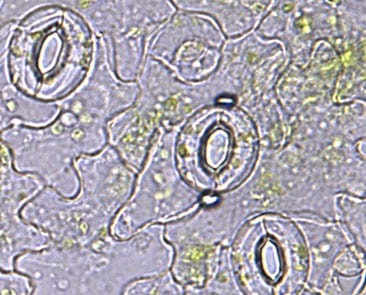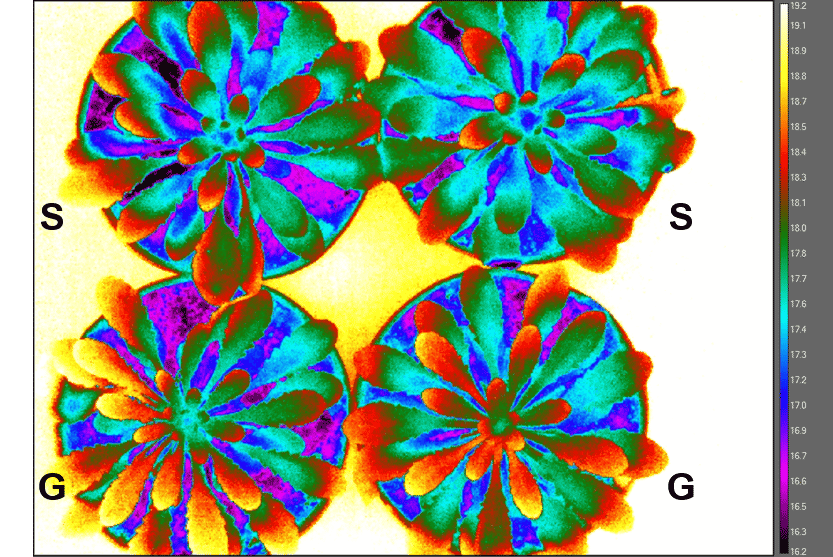Stomata, located on the leaf surface, regulate plant relationships with their environment. They are composed of two guard cells surrounding a pore that enables the plant to transpire and assimilate the atmospheric CO2 necessary for its growth. During environmental constraints, stomata close quickly to limit the effects of stress. Thus, they contribute to reduce water loss in dry conditions and can slow down the intrusion of pathogens. This process involves a complex signaling network, involving notably abscisic acid, a hormone that protects against water stress, and reactive oxygen species that modify the cell redox state.
For several years, the PPV team has been characterizing enzymes that control the redox state of proteins, thus regulating their activity. These enzymes, called thiol reductases, are essential for the development of plants, especially in stressful situations. “Thanks to a proteomic approach that consists in identifying proteins, we have shown that some of them, such as peroxiredoxins or glutaredoxins, are abundant in guard cells and could play a signaling role for the control of the movement of these cells” says Pascal REY, head of the PPV team. To test this hypothesis, the researchers compared the stomatal responses of mutant lines lacking peroxiredoxins or glutaredoxins to those of wild-type plants in the model plant Arabidopsis thaliana.

Under various environmental conditions, they observed that the functioning of guard cells was indeed modified in plants deficient in these enzymes, their stomata closing more rapidly.
“All our results unveiled an important enzymatic step in the control of stomatal closure, thus revealing the participation of thiol reductases in this process, probably through redox exchange” continues Pascal REY. With these results, the PPV team is now pursuing its research to discover the partners of the reductases and to elucidate their roles in the signaling pathways leading to guard cell movements. This knowledge is essential for understanding the functioning of stomata and could help improving the adaptation capacities of plants to climate change.
For several years, the PPV team has been characterizing enzymes that control the redox state of proteins, thus regulating their activity. These enzymes, called thiol reductases, are essential for the development of plants, especially in stressful situations. “Thanks to a proteomic approach that consists in identifying proteins, we have shown that some of them, such as peroxiredoxins or glutaredoxins, are abundant in guard cells and could play a signaling role for the control of the movement of these cells” says Pascal REY, head of the PPV team. To test this hypothesis, the researchers compared the stomatal responses of mutant lines lacking peroxiredoxins or glutaredoxins to those of wild-type plants in the model plant Arabidopsis thaliana.

Infrared imaging of leaf temperature of wild-type (S) and glutaredoxins S14- and S16-deficient (G) Arabidopsis thaliana plants. The color scale on the right indicates temperatures between 16.2°C (purple color) and 19.2°C (yellow color). Plants lacking glutaredoxins show significantly more red or yellow leaves, revealing a higher temperature due to more closed stomata compared to wild-type
The enzyme, an essential actor in cell functioning
Enzymes are the main and ubiquitous actors of cellular metabolism within living organisms. All are assigned specific tasks: some modify molecules like glucids, lipids and proteins, others proceed to new assemblies and syntheses. Here, enzymes play a role in the opening and closing movements of stomata by changing the redox state of partners.
1 Research teams SAVE, Signalisation pour l’Adaptation des Végétaux à leur Environnement, of BIAM, EdyP of CEA-Grenoble and LGDP of CNRS-Perpignan
REFERENCES
Montillet JL, Rondet D, Brugière S, Henri P, Rumeau D, Reichheld JP, Couté Y, Leonhardt N, Rey P. Plastidial and cytosolic thiol reductases participate in the control of stomatal functioning. Plant Cell Environ. 2021; 1– 19.
Full publication : https://doi.org/10.1111/pce.14013